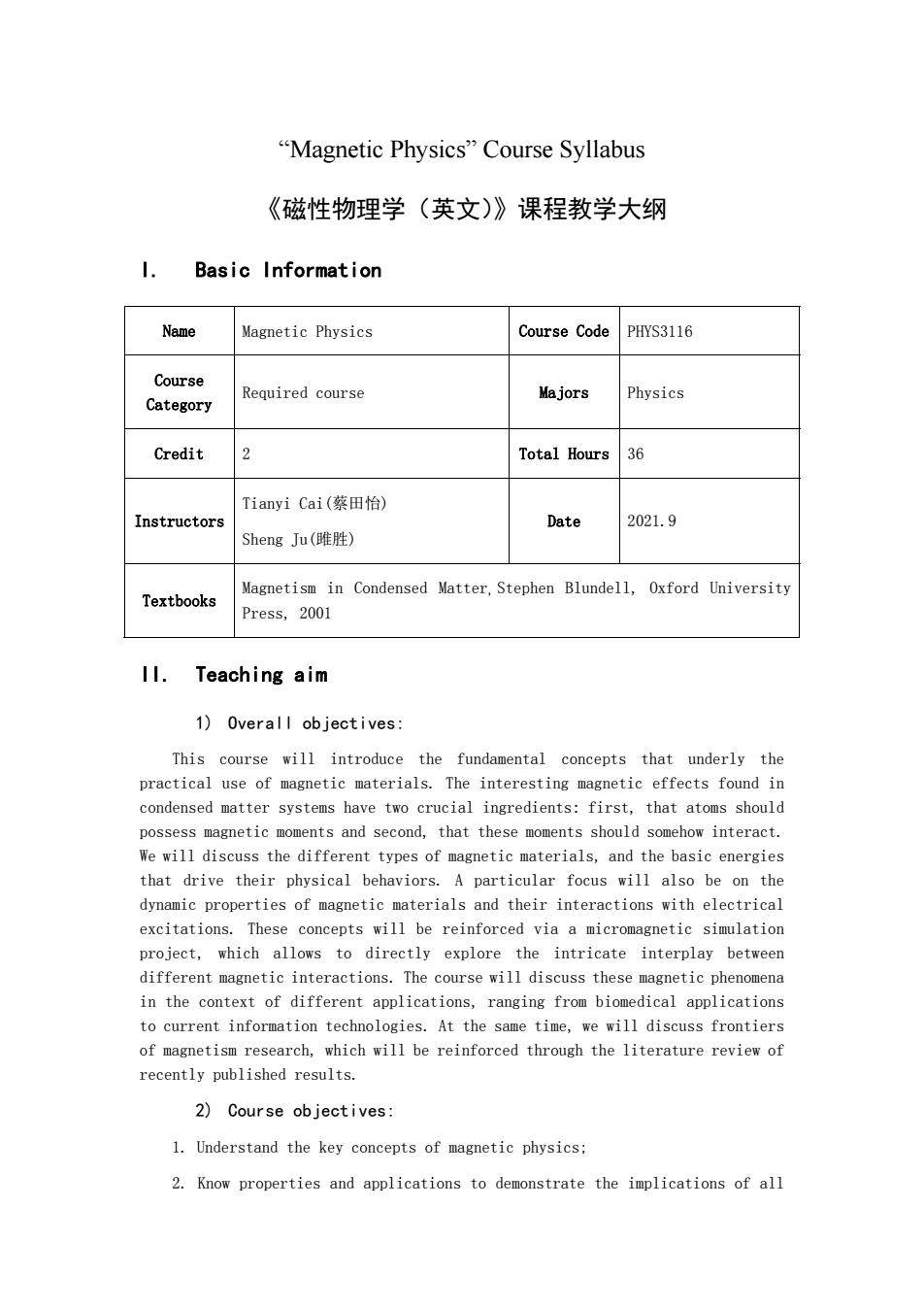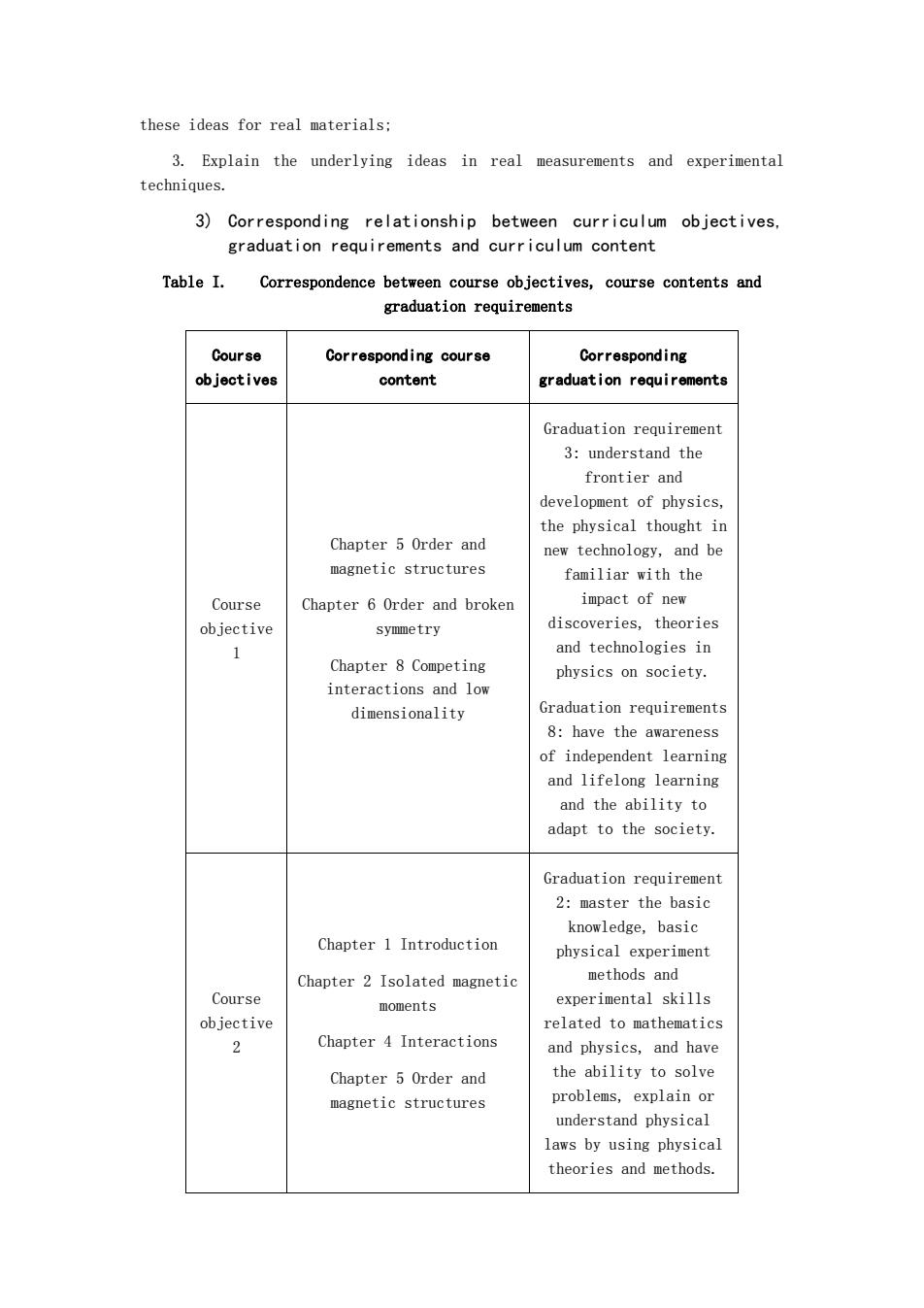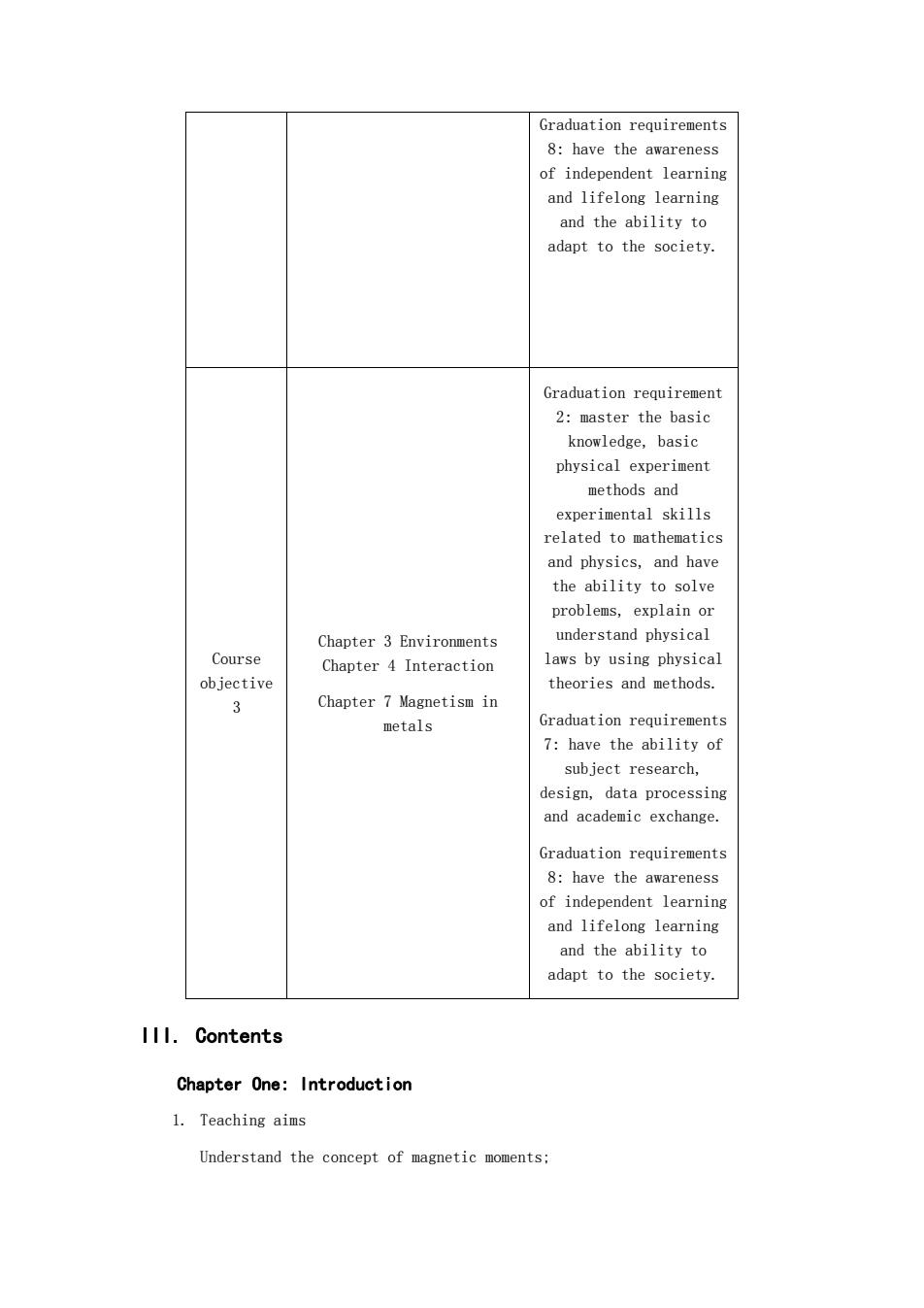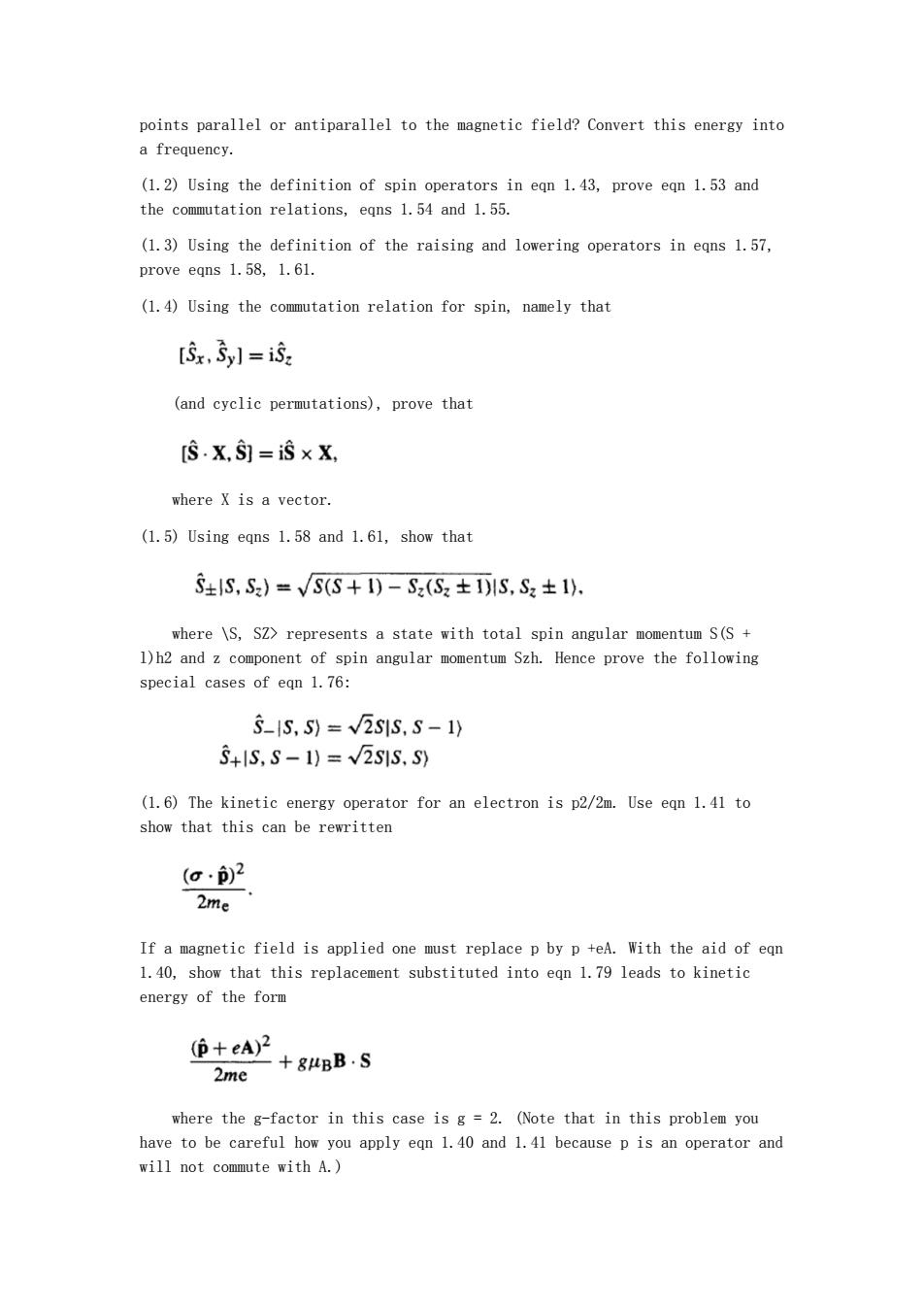
"Magnetic Physics"Course Syllabus 《磁性物理学(英文)》课程教学大纲 1. Basic Information Name Magnetic Physics Course Code PHYS3116 Course Category Required course Majors Physics Credit Total Hours36 Tianyi Cai(蔡田怡) Instructors 2021.9 Sheng Ju(唯胜) Date Textbooks Magnetism in Condensed Matter,Stephen Blundell,Oxford University Press,2001 1I.Teaching aim 1)Overall objectives: This course will introduce the fundamental concepts that underly the practical use of magnetic materials. The interesting gnetic effects found in condensed matter systems have two crucial ingredients:first,that atoms should possess magnetic moments and second,that these moments should somehow interact. We will discuss the different types of magnetic materials,and the basic energies that drive their physical behaviors.A particular focus will also be on the dynamic properties of magnetic materials and their interactions with electrical excitations.These concepts will be reinforced via a micromagnetic simulation project,which allows to directly explore the intricate interplay between different magnetic interactions.The course will discuss these magnetic phenomena in the context of different applications,ranging from biomedical applications to current information technologies.At the same time,we will discuss frontiers of magnetis research,which will be reinforced through the literature revie of recently published results. 2)Course objectives: 1.Understand the key concepts of magnetic physics: 2.Know properties and applications to demonstrate the implications of all
“Magnetic Physics” Course Syllabus 《磁性物理学(英文)》课程教学大纲 I. Basic Information Name Magnetic Physics Course Code PHYS3116 Course Category Required course Majors Physics Credit 2 Total Hours 36 Instructors Tianyi Cai(蔡田怡) Sheng Ju(雎胜) Date 2021.9 Textbooks Magnetism in Condensed Matter, Stephen Blundell, Oxford University Press, 2001 II. Teaching aim 1) Overall objectives: This course will introduce the fundamental concepts that underly the practical use of magnetic materials. The interesting magnetic effects found in condensed matter systems have two crucial ingredients: first, that atoms should possess magnetic moments and second, that these moments should somehow interact. We will discuss the different types of magnetic materials, and the basic energies that drive their physical behaviors. A particular focus will also be on the dynamic properties of magnetic materials and their interactions with electrical excitations. These concepts will be reinforced via a micromagnetic simulation project, which allows to directly explore the intricate interplay between different magnetic interactions. The course will discuss these magnetic phenomena in the context of different applications, ranging from biomedical applications to current information technologies. At the same time, we will discuss frontiers of magnetism research, which will be reinforced through the literature review of recently published results. 2) Course objectives: 1. Understand the key concepts of magnetic physics; 2. Know properties and applications to demonstrate the implications of all

these ideas for real materials: 3.Explain the underlying ideas in real measurements and experimental techniques. 3)Corresponding relationship between curriculum objectives. graduation requirements and curriculum content Table I. Correspondence between course objectives,course contents and Course Corresponding course Corresponding ob jectives content graduation requirements Graduation requirement 3:understand the frontier and development of physics. the physical thought in Chapter 5 Order and new technology,and be magnetic structures familiar with the Course Chapter 6 Order and broker i回bact of new objective discoveries theories symmetry 1 and technologies in Chapter 8 Competing physics on society. interactions and low dimensionality Graduation requirements 8:have the awareness of independent learning and lifelong learning and the ability to adapt to the society. Graduation requiremen 2:master the basic knowledge,basic Chapter 1 Introduction physical experiment Chapter 2 Isolated magneti methods and Course experimental skills moments ob jective related to mathematics 2 Chapter 4 Interactions and physics,and have Chapter 5 Order and the ability to solve magnetic structures problems,explain or understand physical laws by using physical theories and methods
these ideas for real materials; 3. Explain the underlying ideas in real measurements and experimental techniques. 3) Corresponding relationship between curriculum objectives, graduation requirements and curriculum content Table I. Correspondence between course objectives, course contents and graduation requirements Course objectives Corresponding course content Corresponding graduation requirements Course objective 1 Chapter 5 Order and magnetic structures Chapter 6 Order and broken symmetry Chapter 8 Competing interactions and low dimensionality Graduation requirement 3: understand the frontier and development of physics, the physical thought in new technology, and be familiar with the impact of new discoveries, theories and technologies in physics on society. Graduation requirements 8: have the awareness of independent learning and lifelong learning and the ability to adapt to the society. Course objective 2 Chapter 1 Introduction Chapter 2 Isolated magnetic moments Chapter 4 Interactions Chapter 5 Order and magnetic structures Graduation requirement 2: master the basic knowledge, basic physical experiment methods and experimental skills related to mathematics and physics, and have the ability to solve problems, explain or understand physical laws by using physical theories and methods

Graduation requirements 8:have the awareness of independent learnin and lifelong learning and the ability to adapt to the society. Graduation requiremen 2:master the basic knowledge,basic physical experiment methods and experimental skills related to mathematics and physics,and hav the ability to solve problems,explain or Chapter 3 Environments understand physical Course Chapter 4 Interaction laws by using physical objective theories and methods Chapter 7 Magnetism in metals Graduation requirements 7:have the ability of sub iect research. Graduation requirements 8:have the awareness of independent learning and lifelong learning and the ability to adapt to the society. 1II.Contents Chapter One:Introduction 1.Teaching aims Understand the concept of magnetic moments:
Graduation requirements 8: have the awareness of independent learning and lifelong learning and the ability to adapt to the society. Course objective 3 Chapter 3 Environments Chapter 4 Interaction Chapter 7 Magnetism in metals Graduation requirement 2: master the basic knowledge, basic physical experiment methods and experimental skills related to mathematics and physics, and have the ability to solve problems, explain or understand physical laws by using physical theories and methods. Graduation requirements 7: have the ability of subject research, design, data processing and academic exchange. Graduation requirements 8: have the awareness of independent learning and lifelong learning and the ability to adapt to the society. III. Contents Chapter One: Introduction 1. Teaching aims Understand the concept of magnetic moments;

Explain some facts about magnetic moments from elementary classical and quantum physics 2.Keypoints and Difficulties Keypoints:Magnetic moments Difficulties:The classical and quantum understanding of the magnetic moments 3.Contents 1.1 Magnetic moments 1.1.1 Magnetic moments and angular momentum 1.1.2 Precession 1.1.3 The Bohr magneton 1.1.4 Magnetization and field 1.2 Classical mechanics and magnetic moments 1.2.1 Canonical momentum 1.2.2 The Bohr-van Leeuwen theorem 1.3 Quantum mechanics of spin 1.3.1 Orbital and spin angular momentum 1.3.2 Pauli spin matrices and spinors 1.3.3 Raising and lowering operators 1.3.4 The coupling of two spins 4.Teaching method Teaching:Group Discussion:Autodidacticism under the guidance of the teacher 5.Comments Carefully prepare lessons,prepare students and make preparations before class:In the teaching process,we pay attention to cultivating students' creative thinking,take students as the main body and enhance students'sense of participation:Corresponding exercises and supplementary exercises after class. Problems: (1.1)Calculate the magnetic moment of an electron (with g=2).What is the Larmor precession frequency of this electron in a magnetic field of flux density 0.3 T?What is the difference in energy of the electron if its spin
Explain some facts about magnetic moments from elementary classical and quantum physics 2. Keypoints and Difficulties Keypoints: Magnetic moments Difficulties: The classical and quantum understanding of the magnetic moments 3. Contents 1.1 Magnetic moments 1.1.1 Magnetic moments and angular momentum 1.1.2 Precession 1.1.3 The Bohr magneton 1.1.4 Magnetization and field 1.2 Classical mechanics and magnetic moments 1.2.1 Canonical momentum 1.2.2 The Bohr-van Leeuwen theorem 1.3 Quantum mechanics of spin 1.3.1 Orbital and spin angular momentum 1.3.2 Pauli spin matrices and spinors 1.3.3 Raising and lowering operators 1.3.4 The coupling of two spins 4.Teaching method Teaching; Group Discussion; Autodidacticism under the guidance of the teacher 5.Comments Carefully prepare lessons, prepare students and make preparations before class; In the teaching process, we pay attention to cultivating students' creative thinking, take students as the main body and enhance students' sense of participation; Corresponding exercises and supplementary exercises after class. Problems: (1.1) Calculate the magnetic moment of an electron (with g = 2). What is the Larmor precession frequency of this electron in a magnetic field of flux density 0.3 T? What is the difference in energy of the electron if its spin

points parallel or antiparallel to the magnetic field?Convert this energy into a frequency. (1.2)Using the definition of spin operators in eqn 1.43.prove eqn 1.53 and the commutation relations,egns 1.54 and 1.55. (1.3)Using the definition of the raising and lowering operators in eans 1.57, prove eans 1.58.1.61. (1.)Using the commutation relation for spin,namely that [,5l=i (and cyclic permutations),prove that [6.XS=i×X, where X is a vector. (1.5)Using eqns 1.58 and 1.61,show that S±lS,S)=√SS+I)-Sz(S2±S,S2±1. where \S,SZ>represents a state with total spin angular momentum S(S+ 1)h2 and z component of spin angular momentum Szh.Hence prove the following special cases of eqn 1.76: 5-1S,5)=√2S1S,S-1) 5+lS,S-1)=√2S1S.S (1.6)The kinetic energy operator for an electron is p2/2m.Use ean 1.41 to show that this can be rewritter (o·)2 2me If a magnetic field is applied one must replace p by p +eA.With the aid of ean 1.40,show that this replacement substituted into eqn 1.79 leads to kinetic energy of the form (+eA)2 2me +8uBB.S where the g-factor in this case is g=2.(Note that in this problem you have to be careful how you apply eqn 1.40 and 1.41 because p is an operator and will not commute with A.)
points parallel or antiparallel to the magnetic field? Convert this energy into a frequency. (1.2) Using the definition of spin operators in eqn 1.43, prove eqn 1.53 and the commutation relations, eqns 1.54 and 1.55. (1.3) Using the definition of the raising and lowering operators in eqns 1.57, prove eqns 1.58, 1.61. (1.4) Using the commutation relation for spin, namely that (and cyclic permutations), prove that where X is a vector. (1.5) Using eqns 1.58 and 1.61, show that where \S, SZ> represents a state with total spin angular momentum S(S + l)h2 and z component of spin angular momentum Szh. Hence prove the following special cases of eqn 1.76: (1.6) The kinetic energy operator for an electron is p2/2m. Use eqn 1.41 to show that this can be rewritten If a magnetic field is applied one must replace p by p +eA. With the aid of eqn 1.40, show that this replacement substituted into eqn 1.79 leads to kinetic energy of the form where the g-factor in this case is g = 2. (Note that in this problem you have to be careful how you apply eqn 1.40 and 1.41 because p is an operator and will not commute with A.)